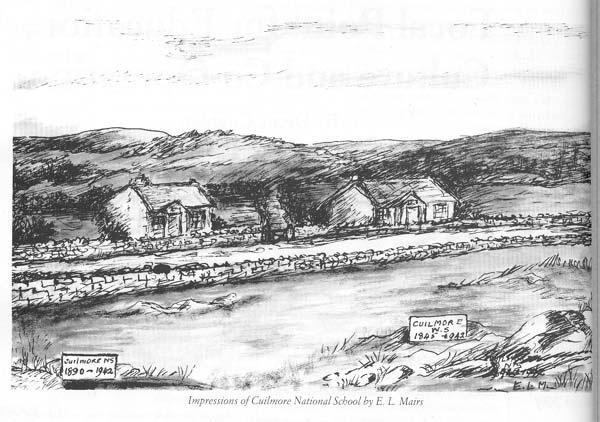
WHEN the heart was torn out of other rural communities with the closure and amalgamation of their national schools, the people of Cuilmore and surrounding districts stood firm and resisted pressure for "progress" from the powers that be.
Today, they and their children celebrate not just the fiftieth anniversary of the building of their local school but the community spirit that has sustained it and made it a special and con- tinuing focal point in terms of education, culture and co-operation.
But Cuilmore National Schoql, built at the foot of "the alley" and at the fringe of Cuilmore Lake on the Castlebar Road, didn't just start 50 years ago. The present building replaced two earlier structures built in 1845 and 1890 which had grown old and out-dated as the modern Irish State developed.
It wasn't until early 1941, when the Second World War was in full swing and emigration was closed off to most people, that the Department of Education finally graqted a contract for building the new school to Mr. Michael O'Boyle of Claremorris.
The job was to build a modern two-teacher school, with cloakrooms ~d outside dry toilets, on the site of the existing buildings and to provide it with a solid, surrounding wall.
To do the job meant the demolition of the original school, now used for boys only and taught in by the principal teacher, Mr. Frank Power. The other, smaller, girls school with teachers, Miss Irene Berry and Mrs. Bridget Mary (Baby) O'Halloran, was left standing and all the students were crammed into it.
The job of laying the foundations of the new school was sub-contracted out to Mr. Peter Spellman and Mr. Pat Doherty of Cuilmore. The job was worth £12 to them but, at the end of two weeks of back-breaking work, a few huge rocks in the yard had them beat. Pick axes and sledges had no effect on these monsters and they lay solidly across the foundation site.
The foundations were mostly dug but, with the huge sandstone blocks sticking up, Mr. O'Boyle would only pay them £10. They had cleared most of the site, using first a wheelbarrow and then an ass and cart to dump the rubble and earth across the road before the "heavy gang" moved in on June 1st, with sharpened steel wedges, crowbars and sledges. Labourers were paid 30 shillings a week and overtime, when available, was at 71/2d per hour. The rocks defeated even their efforts and some of them had, eventually, to be buried by digging deep pits.
Most of the work team was now on the site ganger Bill Tresnan from Claremorris, who stayed at Pakie Callaghan's of Clooneiseal along with Mick Prendergast. A caravan on the site took Paddy Keane and his brother, Michael, from Claremorris, and the others involved were local men.
A charge of 15 shillings (75p) was levied on all the houses of the district to help pay for the new school and it was a considerable sum in those days. Those houses not able to pay provided two days of labour, which put the value of a man's work at seven shillings and sixpence a day.
The locals employed full-time in the building by the contractor were: Peter Doherty of Cuilmore; Tom Keane, Cortoon (the Mountain); Willie O'Hare of Knockglass; Willie Walsh and Dominick Walsh of Derryloughan; Pakie Joyce (the turn) Dromurla; Tom Joyce, Cortoon and Anthony Walsh of Gortnaclasser West.
Mr. Tom Keane drew gravel and sand for the work with a horse and cart from a quarry near his house, but he had to get the finishing, fine sand, from Mr. Willie Roche of Knockglass.

Plasterboard, cement and hardwall came from Carey's stores of Newport, which was then a declining business. The timber, freshly cut and wet as hell -like most war timber -came from O'Hara's timber mills in Ballinrobe, while the slates were delivered by lorry by the contractor. Peter Doherty remembers that the weather was fine during construction and that the work went well. But then, who remembers many wet days that long ago?
In any event, they built the walls using a wooden casing. It had an inside shell of breeze blocks, made up on site, and concrete was poured as an outer layer. The walls rose in three- foot stages.
These were the war years. The years of rationing, when you got 2 ozs of tea a week and 31/21bs of flour. Little time was spent boiling kettles and 'brewing up' as a result and each man brought his own grub.
They worked solidly through the winter and, by the end of February of 1942, the job was completed, including the wall and the outside latrines.
There is no record of an official opening, or of a public blessing by Canon E. F. McGough or by Fr. James Walsh C.C. But the celebrations and th local satisfaction at a job well done must have been intense. The quality of the work -apart from the war windows -is still there to be seen.
The last job was the demolition and removal of the old gir!s school; work which was quickly accomplished. Apart from modern facilities, like toilets, running water, shelters and central heat- ing, the structure remains unchanged -a monu- ment to the people and the community who built it, funded it and, perhaps most importantly, fought against great odds to preserve it.